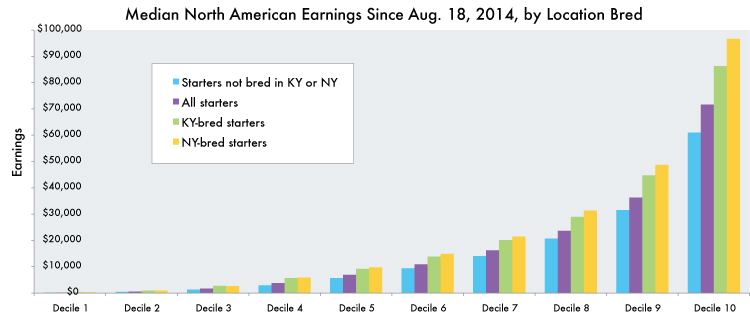MarketWatch: NY-Bred Earning Power

Originally published in the Aug. 24 edition of Blood-Horse Daily. To download the Blood-Horse Daily smartphone app or to receive the edition in your inbox each evening, visit BloodHorse.com/Daily.
Twelve years ago when a New York-bred gelding won two-thirds of the Triple Crown, many saw it as an improbable accomplishment. Even Steve Haskin's lede in The Blood-Horse magazine had an air of disbelief: "Start spreadin' the news. A New York-bred has won the Kentucky Derby (gr. I)."
While Funny Cide proved Thoroughbreds didn't have to take their first steps on Kentucky bluegrass to win Kentucky's biggest race, it wasn't like he was devoid of Kentucky connections. After all, he had been conceived in Kentucky to the cover of Distorted Humor , who later led North America's general sire list.
A similar recipe of Kentucky-sired New York-breds continues to produce elite talent—last year's champion grass mare Dayatthespa (City Zip ) being a recent example. For the current crop of New York-bred 2-year-olds, Kentucky stallions sired 38% compared with 56% by New York stallions.
At the same time, the New York stallion colony is improving. At Fasig-Tipton's Saratoga New York-bred preferred yearling sale, Mandy Pope's Whisper Hill Farm—known for collector's-item purchases Havre de Grace, Plum Pretty, and Groupie Doll—bought three fillies by New York stallion Mission Impazible , further evidence that mainstream buyers are paying more attention to New York.
"We enjoy running in the New York-bred program," Pope said. "The purses are so good for them, and the horses can actually pay for themselves (on the racetrack)."
Earlier in the week at the select sale, Craig Bernick of Glen Hill Farm purchased a New York-bred War Front filly for $570,000.
"You don't buy a horse for that amount of money because of where they're bred," Bernick said. "But I'm sure she'll run in the New York-bred races for a lot of money, and then hopefully she's good enough to run in open company."
Since Funny Cide's 3-year-old season, New York has pumped purse incentives into its state-bred program. According to The Jockey Club Fact Book, the $86,963,418 earned by New York-breds in 2014 was 51% higher than their earnings in Funny Cide's Derby year of 2003, and the $28,318 average per starter in 2014 was 56% better than in 2003.
New York-breds now have more earning potential than their Kentucky counterparts. MarketWatch divided North American starters over the past 12 months into groups by state bred. In each group we placed the horses into deciles by their earnings in the past year.
Horses in Decile 1 are the bottom 10% of earners in their group; Decile 10 horses are the top 10% of earners. In all but one (Decile 3), New York-breds had higher median earnings than the Kentucky-breds.

